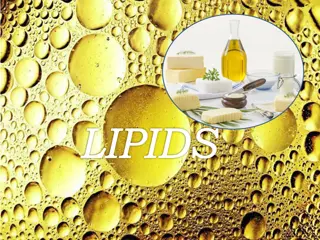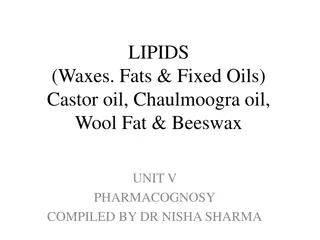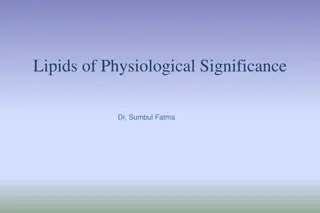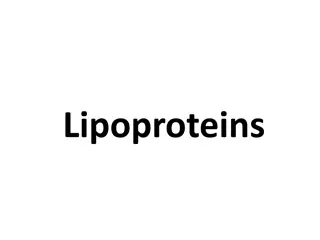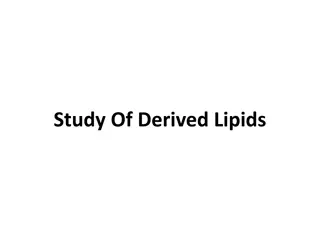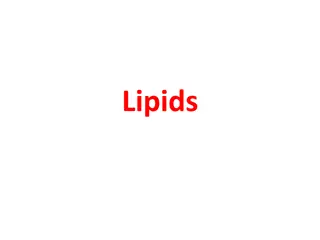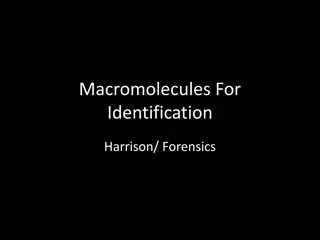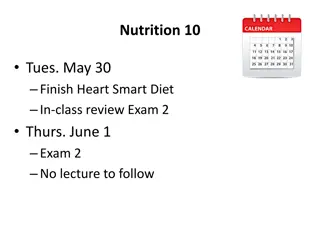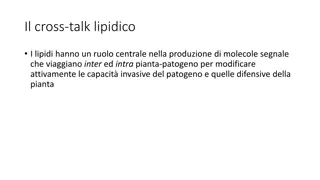Complex Lipids: Glycerophospholipids and Sphingolipids
Complex lipids play crucial roles in cellular structure and function. Glycerophospholipids, such as phosphatidylcholine, are amphipathic molecules with hydrophobic fatty acid chains and hydrophilic head groups. They are key components of cell membranes. Sphingolipids, including sphingomyelin and ceramides, are found in brain tissues and are derivatives of sphingosine. These lipids contribute to cell signaling and integrity. Understanding the structures and functions of these complex lipids is essential in biological systems.
Download Presentation

Please find below an Image/Link to download the presentation.
The content on the website is provided AS IS for your information and personal use only. It may not be sold, licensed, or shared on other websites without obtaining consent from the author.If you encounter any issues during the download, it is possible that the publisher has removed the file from their server.
You are allowed to download the files provided on this website for personal or commercial use, subject to the condition that they are used lawfully. All files are the property of their respective owners.
The content on the website is provided AS IS for your information and personal use only. It may not be sold, licensed, or shared on other websites without obtaining consent from the author.
E N D
Presentation Transcript
Complex Lipids: Glycerophospholipids 2
Glycerophospholipids Glycerophospholipids are similar in structure to triglycerides except that they only have two esterified fatty acids. The third position on backbone instead contains a phospholipid head group. The two fatty phospholipids are normally 14 to 24 carbon atoms long, with one fatty acid saturated and unsaturated. the glycerol acids in commonly the other 3
Glycerophospholipids There are several types of phospholipid head groups, such as: choline, inositol, serine, and ethanolamine, which are all hydrophilic in nature. The various types of glycerophospholipids are named based on the type of phospholipid head group present, e.g. phosphatidylcholine. 4
Glycerophospholipids Because glycerophospholipids contain both hydrophobic fatty acid C H chains and a hydrophilic head group, they are by definition amphipathic lipid molecules and, as such, are found on the surface of lipid layers. The polar hydrophilic head group faces outward the aqueous environment, whereas the fatty acid chains face inward away from the water in a perpendicular orientation with respect to the lipid surface. 5
Complex Lipids: Sphingolipids (Sphingomyelin, Cerebrosides and Gangliosides) 6
Sphingolipids Shingolipids are typically found in brain tissues. Sphingolipids are derivatives of the C18 amino alcohols dihydrosphingosine, and their C16, C17, C19, and C20 homologs. Sphingosine is rare in plants and animals while sphingolipids are common. sphingosine, 7
Sphingolipids Simplest sphingolipids are ceramides. Sphingosine + N-linked fatty acid = ceramide Ceramides occur only in small amounts in plant and animal tissues but form the parent compounds of more abundant sphingolipids: 1. Sphingomyelins. 2. Cerebrosides. 3. Gangliosides. 9
Sphingolipids: 1. Sphingomyelin Sphingomyelin significant sphingophospholipid in humans. The backbone of sphingomyelin is the amino alcohol sphingosine, rather than glycerol. A long-chain fatty acid is attached to the amino sphingosine through an amide linkage, producing a ceramide, which can also serve as a precursor of glycolipids. the only group of 10
Sphingolipids: 1. Sphingomyelin The alcohol group at carbon 1 of sphingosine esterified phosphorylcholine, producing sphingomyelin. They can also be classified as sphingophposholipids. Sphingomyelin important constituent of the myelin of nerve fibers. is to is an 11
Sphingolipids: 2. Cerebrosides Cerebrosides, the simplest sphingoglycolipids (alternatively glycosphingolipids), are ceramides with head groups that consist of a single sugar residue. The carbohydrates are most often glucose or galactose. Cerebrosides, in contrast to phospholipids, lack phosphate groups and hence are most frequently nonionic compounds. 12
Sphingolipids: 2. Cerebrosides Galactocerebrosides: Most prevalent in the neuronal cell membranes of the brain. have a -D-galactose head group. 13
Sphingolipids: 2. Cerebrosides Glucocerebrosides: They occur mostly in non-neuronal tissues. have a -D-glucose head group. 14
Sphingolipids: 3. Gangliosides Gangliosides form the most complex group of sphingolipids. They are ceramide oligosaccharides that include among their sugar groups at least one sialic acid residue. Gangliosides are primarily components of cell surface membranes and constitute a significant fraction of brain lipids. Other tissues also contain gangliosides but in lesser amount. 15
Sphingolipids: 3. Gangliosides Glycosphingolipids are the determinants of blood types. * The symbol Fuc represents the sugar fucose. 17
Waxes 18
Waxes Waxes esters of fatty acids and fatty alcohols. They protect the skin of plants and animal. Natural protective layer in fruits and vegetables. are typically fur of 19
Waxes Weakly group with saturated fatty acid unsaturated alcohol (typically). polar head and fatty 20
Steroids: Cholesterol and Bile Acids 21
Steroids Another major class of lipids is steroids, which have structures totally different from the other classes of lipids. The main feature of steroids is the ring system of three cyclohexanes and one cyclopentane in a fused ring system. There are a variety of functional groups that may be attached. The main feature, as in all lipids, is the large number of carbon- hydrogens which make steroids non-polar. 22
Steroids Steroids include such well known compounds as: Cholesterol Male & female sex hormones Bile acids Vitamin D Adrenal corticosteroids 23
Cholesterol Cholesterol is an unsaturated steroid alcohol. It consists of four fused hydrocarbon rings (A, B, C, and D) called the steroid nucleus ), and it has an eight-carbon, branched hydrocarbon chain attached to carbon 17 of the D ring. Ring A has a hydroxyl group at carbon 3, and ring B has a double bond between carbon 5 and carbon 6 Cholesterol is a very hydrophobic compound. The only hydrophilic part of cholesterol is the hydroxyl group in the A- ring. It is, therefore, also an amphipathic lipid and is found on the surface of lipid layer along with phospholipids. 24
Cholesterol Cholesterol can also exist in an esterified form called cholesterol ester, with the hydroxyl group conjugated by an ester bond to a fatty acid, in the same way as in triglycerides. In contrast to free cholesterol, there are no polar groups on cholesterol esters, making them very hydrophobic. Because it is not charged, cholesterol ester are classified as a neutral lipid and are not found on the surface of lipids layers but instead are located in the center of lipoproteins, along with triglycerides. lipid drops and 25
Cholesterol Cholesterol is almost exclusively synthesized by animals, but plants do contain other sterols similar in structure to cholesterol. Cholesterol is also unique in that, unlike other lipids, it is not readily catabolized by most cells and, therefore, does not serve as a source of fuel. Cholesterol performs a number of essential functions in the body. For example: Cholesterol is a structural component of all cell membranes, modulating their fluidity. In specialized tissues, cholesterol is a precursor of bile acids, steroid hormones, and vitamin D. It is therefore of critical importance that the cells of the body be assured an appropriate supply of cholesterol. 26
Synthesis of Cholesterol Occurs in cytosol. Requires NADPH, ATP, and O2. Highly regulated. 80 % in liver, ~10% intestine, ~5% skin. The overall equation: 27
Synthesis of Cholesterol Cholesterol is synthesized by virtually all tissues in humans, although intestine, adrenal cortex, and reproductive tissues, including ovaries, testes, and placenta, make the largest contributions to the body s cholesterol pool. liver, 28
Cholesterol The liver plays a central role in the regulation of the body s homeostasis. For example, cholesterol enters the liver s cholesterol pool from a number of sources including dietary cholesterol, as well as cholesterol synthesized de novo by extrahepatic tissues and by the liver itself. cholesterol 29
Synthesis of Cholesterol The key step in the biosynthesis of cholesterol is the conversion of 3-hydroxy-3-methyl-glutaryl-Coenzyme A to mevalonate by HMG CoA reductase. This is the rate limiting step in cholesterol biosynthesis. 30
Degradation of Cholesterol The cholesterol metabolized to CO2 and H2O in humans. Rather, the intact sterol nucleus is eliminated from the body by conversion to bile acids and bile salts, which are excreted in the feces, and by secretion of cholesterol into the bile, which transports it to the intestine for elimination. ring structure cannot of be 32
Degradation of Cholesterol Some of the cholesterol in the intestine is modified by bacteria before excretion. The primary compounds made are the isomers coprostanol cholestanol, reduced derivatives cholesterol. Together with cholesterol, compounds make up the bulk of neutral fecal sterols. and are of which these 33
Bile Acids and Bile Salts Bile consists of a watery mixture of organic and inorganic compounds. Phosphatidylcholine and bile salts (conjugated bile acids) are quantitatively the most important organic components of bile. Bile can either pass directly from the liver where it is synthesized into the duodenum through the common bile duct, or be stored in the gallbladder when not immediately needed for digestion. 34
Structure of Bile Acids The bile acids contain 24 carbons, with two or three hydroxyl groups and a side chain that terminates in a carboxyl group. The bile acids are amphipathic in that the hydroxyl groups are in orientation (they lie below the plane of the rings) and the methyl groups are (they lie above the plane of the rings). Therefore, the molecules have both a polar and a nonpolar face, and can act as emulsifying agents in the intestine, helping prepare dietary triacylglycerol and other complex lipids for degradation by pancreatic digestive enzymes. 35
Synthesis of Bile Acids Bile acids are synthesized in the liver by a multistep, multiorganelle pathway The most resulting cholic acid (a triol) and chenodeoxycholic acid (a diol), are called primary bile acids. common compounds, 36
Synthesis of Bile Salts Before the bile acids leave the liver, they are conjugated to a molecule of either glycine or taurine by an amide bond between the carboxyl group of the bile acid and the amino group of the added compound. These new structures include glycocholic and glycocheno- deoxycholic taurocholic and taurocheno- deoxycholic acids acids, and 37
Lipoproteins 38
Plasma Lipoproteins The spherical complexes of lipids and specific proteins (apolipoproteins apoproteins). Lipoproteins function: The main role is the delivery of fuel to peripheral cells. to provide an efficient mechanism for transporting their lipid contents to (and from) the tissues. to keep their component lipids soluble as they transport them in the plasma. plasma lipoproteins macromolecular are or 39
Plasma Lipoproteins The lipoprotein particles include: chylomicrons (CM), very-low-density lipoproteins (VLDL), low-density lipoproteins (LDL), high-density lipoproteins (HDL). They differ in lipid and protein composition, size (range from 10 to 1200 nm), density, and site of origin. [Note: Although cholesterol and its esters are shown as one component in the center of each particle, physically cholesterol is a surface component whereas cholesteryl esters are located in the interior of the lipoproteins.] 40
Apolipoproteins Apolipoprotein are primarily located on the surface of lipoprotein particles. Apolipoproteins are divided by structure and function into five major classes, A, B, C, D, and E, with most classes having subclasses. For example, apolipoprotein (or apo) A-I and apo C-II. Functions: providing recognition sites for cell-surface receptors they help maintain the structural integrity of lipoproteins serving as activators or coenzymes for enzymes involved in lipoprotein metabolism. [Note: Functions of all of the apolipoproteins are not yet known.] 41
Composition of plasma lipoproteins Lipoproteins are composed of a neutral lipid triacylglycerol and cholesteryl esters) surrounded by a shell of amphipathic apolipoproteins, phospholipid, and non-esterified (free) cholesterol. These amphipathic compounds are oriented so that their polar portions are exposed on the surface of the lipoprotein, thus making the particle soluble in aqueous solution. The triacylglycerol and cholesterol carried by the lipoproteins are obtained either from the diet (exogenous source) or from de novo synthesis (endogenous source). core (containing 42
Size and density of lipoprotein particles Chylomicrons are the lipoprotein particles lowest in density and largest in size, and contain the highest percentage of lipid and the lowest percentage of protein. VLDLs and LDLs are successively denser, having higher ratios of protein to lipid. HDL particles are the densest. 43
Chylomicrons Chylomicrons are the largest and least dense of the lipoproteins. These 1000-nanometer particles originate in the intestinal mucosa. Their function is to transport dietary triglycerides cholesterol absorbed intestinal epithelial cells. Chylomicrons contain about 1-2% protein, 85-88% ~8% phospholipids, cholesteryl esters cholesterol. and the by triglycerides, ~3% ~1% and 44
very-low-density lipoproteins (VLDL) Very low density lipoproteins are approximately nanometers in size. produced primarily by the liver with lesser amounts contributed by the intestine VLDL contains 5-12% protein, 50-55% triglycerides, phospholipids, cholesteryl esters and 8-10% cholesterol. leaves a residue of cholesterol in the tissues during the process of conversion to LDL. 25-90 18-20% 12-15% 45
low-density lipoproteins (LDL) Low cholesterol) are smaller than VLDL, approximately 26 nanometers. LDL contains 20-22% protein, 10-15% triglycerides, 20-28% phospholipids, 37-48% cholesteryl esters, and 8-10% cholesterol. LDL is produced by the liver. LDL and HDL transport both dietary and endogenous cholesterol in the plasma, but LDL is the main transporter of cholesteryl esters and makes up more than half of the total lipoprotein in plasma. density lipoproteins (bad cholesterol and 46
high-density lipoproteins (HDL) High density lipoproteins (good cholesterol) are the smallest of the lipoproteins. HDL particles have a size of 6-12.5 nanometers. HDL contains approximately 55% protein, 3- 15% triglycerides, 26-46% phospholipids, 15- 30% cholesteryl esters, cholesterol. HDL is produced in the liver and intestine . HDL contains a large number of different proteins including apolipoproteins such as apo-AI (apolipoprotein A1), apo-CI, apo-CII, apo-D, and apo-E. The HDL proteins serve in lipid metabolism, complement regulation, and participate as proteinase inhibitors response to support the immune system against inflammation and parasitic diseases. and 2-10% and acute phase 47
LDL vs HDL 48
Plasma Lipoproteins In humans, the transport system is less perfect than in other animals and, as a result, humans experience a gradual deposition of lipid especially tissues. This is a potentially life-threatening occurrence when the lipid deposition contributes formation, narrowing of blood vessels (atherosclerosis). cholesterol in to plaque the causing 49


